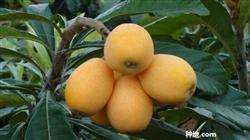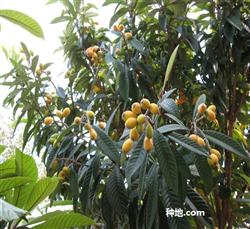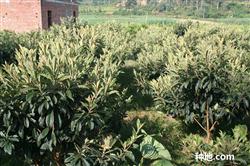How to grow loquat with high yield

How to grow loquat with high yield? There are those aspects to pay attention to the cultivation of loquat can refer to the following: loquat is not only rich in nutrition, has a unique taste, but also on the market when the fruit off-season, the market best-selling. Therefore, the cultivation of loquat has good economic benefits. In order to obtain a good harvest of loquat, in addition to selecting improved varieties, we should also pay attention to the following measures: first, scientific fertilization, promoting flower fertilizer. Flower-promoting fertilizer should be applied early, usually before budding in early September, accounting for about 25% of the total amount of fertilizer applied in the whole year. Each adult tree applied 3 kg of available cake fertilizer, 30 kg of human and animal fecal water, and 1 kg of compound fertilizer. 2. Strong fruit and fat. It was applied within one week before the spring shoot was born in early March, and the amount of fertilizer applied accounted for 25% of the total amount of fertilizer applied in the whole year. Each adult tree applies 2 kg of rotten cake fertilizer, 0.25 kg of urea, 1 kg of compound fertilizer, 30 kg of human and animal manure water and 1 kg of phosphate fertilizer. 3. Fruit-picking fertilizer. Timely heavy fertilization before fruit harvest is the guarantee of high yield of loquat next year, which accounts for 50% of the total amount of fertilizer applied in the whole year. Each adult tree applies 5 kg of rotten cake fertilizer, 0.25 kg of urea, 50 kg of human and animal manure, 100 kg of manure and 2 kg of phosphate fertilizer. 4. Extra-root topdressing. According to the growth of the tree and the situation of fruit setting, extra-root topdressing can be carried out many times throughout the year. It is generally sprayed with 0.3% multi-element compound fertilizer or 0.3% urea solution. Second, summer pruning. Summer pruning can not only quickly restore the tree potential, but also stimulate the germination of summer shoots and ensure a bumper harvest year after year. Summer pruning should be completed within 10 days after fruit harvest, and new shoots can germinate after pruning. If the pruning is too late, the summer shoots can not fully mature, which hinders the formation of flower buds and reduces the yield of the following year. The dense branches, cross branches and overlapping branches are mainly thinned, and only 2 strong branches are left on each branch; the pruning of the long branches should be determined according to the location, and heavy cutting should be taken when space is available, so that the mother branches or reserve branches are produced. In general, the long branches should be thinned from the base. The fruiting mother branch with strong growth may not be trimmed, and the fruiting mother branch with weak growth potential should leave 3-4 leaves at the base for short interception as preparation branches, and for adult trees with closed crown, the middle erect branches should be removed to improve the light conditions and promote hidden bud germination in the middle and lower part of the crown, so as to achieve the purpose of three-dimensional fruiting, and remove all the weak twigs, dense branches, disease and insect branches around the crown. The senile trees should be re-cut off the main branches and secondary branches every year, and the whole tree should be renewed in two or three years. Third, flower and fruit protection and fruit thinning 1, flower and fruit protection. Spray nutrients and plant growth regulators. The foliar spraying of 10PPM "92 ○" in loquat flowering stage could increase the fruit setting rate by 38.5%. Spraying with the mixture of 0.25% potassium dihydrogen phosphate and 0.2% urea at flowering 2 / 3 could increase the fruit setting rate by 34.8%. 2. Thinning fruit. The fruits were thawed first, and then the fruits were thinned. There were 2-3 fruits per panicle for large fruit varieties, 3-5 fruits per panicle for middle fruit varieties and 5-8 fruits per panicle for small fruit varieties. Fourth, anti-cracking fruit and sunburn. From the end of March before fruit ripening, covering the tree plate with weeds, straw and straw can play the role of cooling and moisturizing. In case of high temperature and drought, water should be sprayed in time. Spraying 0.14% ethephon solution during the fruit color conversion period (from turquoise to light green), spraying once a week for 2-3 times, could prevent loquat fruit cracking, reduce fruit rust spots, orange-red color, soft and succulent pulp, and mature 7-10 days ahead of time. Fifth, drainage and drought resistance. Loquat is afraid of both drought and stagnant water. If there is no rain for a long time during the flowering period, withered flowers will form. Young fruit is easy to form shrunken fruit after a long drought, so measures such as mulching, furrow irrigation and water spraying should be taken in time to fight drought. In the rainy season, it is easy to cause root rot and cause dead trees, so it is necessary to dredge the ditches in time and eliminate stagnant water. For heavy clay, you can dig a drainage ditch 1 meter deep in the garden and bury pebbles to facilitate drainage. Click to see more loquat planting techniques click to see more fruit planting techniques
- Prev

How to fertilize loquat scientifically
How to plant loquat trees with high yield? What skills do you have? Loquat is the earliest ripe fruit variety in a year. High-quality Loquat-Shaped Cake has large size, few kernels, orange, red and bright skin, soft and juicy pulp, moderate sweetness and sour, unique flavor and rich nutrition, which has the effects of clearing heat, moistening lungs, relieving cough, invigorating stomach and so on. In recent years, high quality cymbals.
- Next

How to control diseases and insect pests in loquat trees?
How to control diseases and insect pests by planting loquat? In what season, we should pay more attention to the prevention and control of anthracnose and pear heart borer in loquat planting. 1. Anthrax is mainly harmful to fruits, and leaves and shoots are also seriously damaged in some years. Some years of the disease are very serious, some years are very light. The first disease of the fruit.
Related
- Moge, come on! The staff of the peasant association in the producing area of cantaloupe were frightened when the crowd gathered.
- Causes and Solutions of low Fruit setting rate of Apple
- Symptoms and control measures of passion fruit virus disease
- Fruit growing lesson: how do apple orchards keep high yields?
- Can you build orchards in the mountains? What are the pros and cons?
- How to manage the coloring period of Crisson grape?
- This paper introduces the processing technology of two kinds of fig products.
- How much is a month for retired teachers in rural areas by 2020?
- How can strawberry planting increase sugar content? We should pay attention to management in many aspects.
- What are the cultivation techniques on how to improve the yield of golden fruit?

